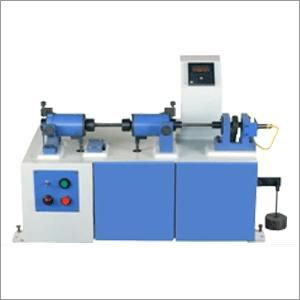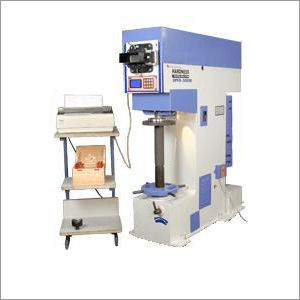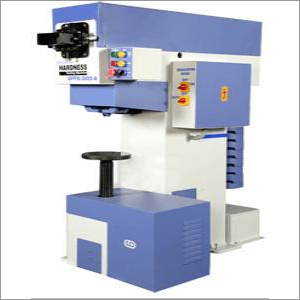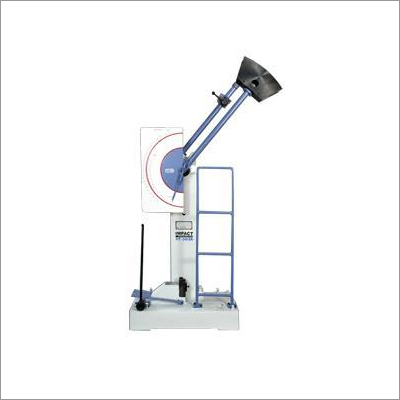Optical Brinell Hardness Tester
Optical Brinell Hardness Tester Specification
- Specimen Size
- Maximum 200 mm height
- Test Range
- 8 to 650 HB
- Resolution
- 0.001 mm
- Max Height
- 200 mm
- Response Time
- Immediate (manual observation)
- Humidity
- 85%
- Port Size
- Standard: 10 mm
- Number of Specimens
- 1 at a time
- Operating Voltage
- 220V AC
- Temperature
- 10C to 35C
- Accuracy
- Complies to IS:2281, BS:240, ASTM:E10
- Hardness
- Brinell scale
- Application
- Metals Hardness Measurement
- Mounting Type
- Bench/Stand Mounted
- Equipment Type
- Brinell Hardness Tester
- Features
- Precise load application, robust construction, optical measurement
- Frequency
- 50 Hz
- Power Supply
- 220V AC, 50Hz
- Usage
- Laboratory, Industrial
- Capacity
- 3000 kgf
- Machine Weight
- 145 kg approx
- Test Speed
- 0.05 mm/sec
- Test Width
- 68 mm
- Test Stroke
- 200 mm
Optical Brinell Hardness Tester Trade Information
- Minimum Order Quantity
- 1 Unit
- Supply Ability
- 04 Units Per Month
- Delivery Time
- 3-8 Week
About Optical Brinell Hardness Tester
Optical Brinell Hardness Tester
Our highly experienced and professional team of experts enables us in offering a superior array of Optical Brinell Hardness Tester. These testers are designed for brinell hardness measurement on steel, ferrous material & also on non-ferrous material like brass, bronze and aluminum. Our Optical Brinell Hardness Tester is manufactured in accordance with international mechanical standards using optimum grade materials. These testers are tested by the experts before the final dispatch in order to make sure that they perform flawlessly.
Features
AATOUS has developed Brinell Hardness Testing Machine with optical device. Basic machine design and operation is similar to simple Hydraulically operated Brinell Tester But, with built - in optical device with 14 X magnification provided in front to project diameter of ball impression on glass screen with a micrometer measuring system with 0.01 mm least count. In this machine the indentor swivells and projects diameter of ball impression immediately after unloading operation which avoids additional time for measurement of ball impression. This is a production testing machine. This is suitable for foundry, forging shops, heat treatment shops, engineering institutions etc.
Robust Construction, Superior Accuracy
Engineered with a heavy-duty casting frame, this tester ensures minimal vibration and maximum stability during tests. The inclusion of a precision micrometer stage and a high quality microscope allows for accurate optical measurements, achieving a fine resolution of 0.001 mm. These features collectively enhance measurement reliability and repeatability for diverse metal specimens.
Comprehensive Testing Capability
This device offers a wide testing range (8 to 650 HB) and supports various load steps from 500 kgf up to 3000 kgf. Interchangeable indenter balls in 2.5mm, 5mm, and 10mm diameters add flexibility, making it suitable for a broad array of metals. Its design accommodates specimens up to 200 mm in height, fulfilling both laboratory and industrial applications.
User-Friendly and Certified Operation
Equipped with overload protection, adjustable sample support table, and manual reading with an option for digital documentation, this machine simplifies the hardness testing process. Each unit is accompanied by a calibration certificate and complies strictly with international standards (IS2281, ASTM E10, BS 240), ensuring trustworthy results for quality assurance.
FAQs of Optical Brinell Hardness Tester:
Q: How does the Optical Brinell Hardness Tester measure metal hardness?
A: The tester applies a controlled load through a hardened steel or tungsten carbide ball indenter onto the metal sample. The resulting indentation is examined using a high quality 20x microscope, and the diameter is measured for hardness calculation. This optical measurement ensures precision in evaluating hardness according to Brinell standards.Q: What is the process for using the optical measurement head?
A: To use the optical measurement head, position the sample on the adjustable table, select the desired load, and initiate the test. After indentation, focus the included microscope with the micrometer stage on the impresssion, measure its diameter manually or document digitally, and interpret the hardness value from Brinell charts.Q: When should calibration be performed and is a certificate included?
A: Calibration ensures consistent accuracy and should be performed according to your laboratorys schedule or after relocation or servicing. Each machine is supplied with a calibration certificate that confirms compliance with IS2281, ASTM E10, and BS 240 standards.Q: Where can this Brinell hardness tester be used?
A: Designed for versatility, the equipment is suitable for laboratory and industrial environments, including metal manufacturers, quality control labs, and research facilities. Its robust construction and adaptability make it effective for use in diverse conditions across India and beyond.Q: What benefits does the overload protection feature provide?
A: Overload protection safeguards both the machine and the test specimen from accidental overloading, thereby ensuring operator safety and maintaining the equipments accuracy and longevity. It also minimizes the risk of damage during setup or testing.Q: How is data output managed with this tester?
A: The machine provides manual readings of indentation measurements but is also equipped with provisions for digital documentation, making it easy to record and archive results for future reference or reporting needs.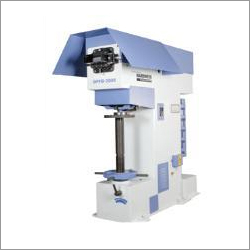

Price:
- 50
- 100
- 200
- 250
- 500
- 1000+
More Products in Material Testing Equipments Category
FATIGUE TESTING MACHINE
Price Range 10000.00 - 600000.00 INR / Unit
Minimum Order Quantity : 1 Unit
Power Supply : 230 V AC, 50 Hz, Single Phase
Features : Counter, Fracture Detection, Cycle Recording
Test Speed : 3000 RPM
Machine Weight : 90 kg (Approx.)
Mechanical Brinell Hardness Tester
Price Range 10000.00 - 600000.00 INR / Unit
Minimum Order Quantity : 1 Unit
Power Supply : 230V AC, 50 Hz
Features : Robust construction, precision loading, easy specimen placement
Test Speed : Standard manual operation
Machine Weight : Approx. 180 kg
OPTICAL BRINELL HARDNESS TESTING MACHINE
Price Range 10000.00 - 600000.00 INR / Unit
Minimum Order Quantity : 1 Unit
Power Supply : 220V AC, 50Hz
Features : High accuracy, Durable body, Manual/optical measuring
Test Speed : Standard
Machine Weight : Approx. 450 kg
ANALOG CHARPY / IZOD IMPACT TESTING MACHINE
Price Range 10000.00 - 600000.00 INR / Unit
Minimum Order Quantity : 1 Unit
Power Supply : 230 V AC, 50 Hz
Features : Dual test support (Charpy & Izod), Robust construction
Test Speed : 3.8 m/s (Charpy), 3.5 m/s (Izod)
Machine Weight : Approx. 120 kg
Factory Address :
Plot No 47, Emerald Indl Estate, Kidc Indl Area, Deku Village, Khalapur Taluk,
Khopoli Raigad, Maharahtra

 Send Inquiry
Send Inquiry
